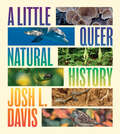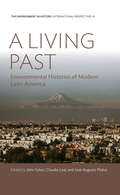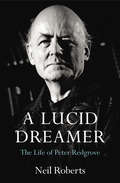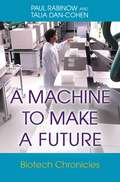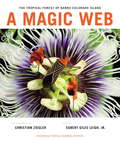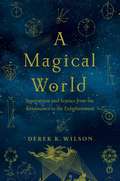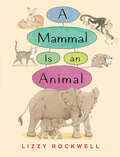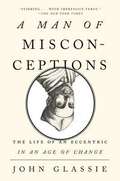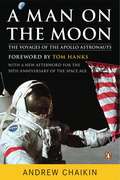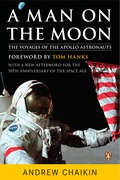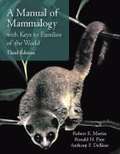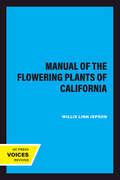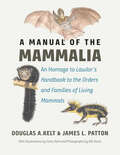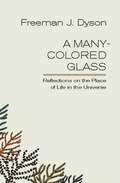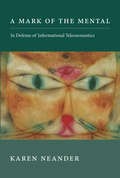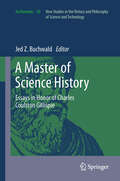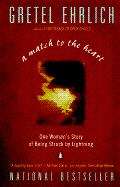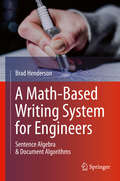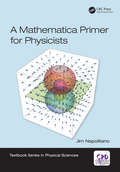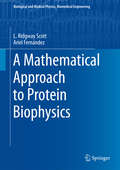- Table View
- List View
A Little Queer Natural History
by Josh L. DavisBeautifully illustrated and scientifically informed, a celebration of the astonishing diversity of sexual behavior and biology found in nature. From a pair of male swans raising young to splitgill mushrooms with over 23,000 mating types, sex in the natural world is wonderfully diverse. Josh L. Davis considers how, for many different organisms—animals, plants, and fungi included—sexual reproduction and sex determination rely on a surprisingly complex interaction among genes, hormones, environment, and chance. As Davis introduces us to fascinating biological concepts like parthenogenesis (virgin birth), monoecious plants (individuals with separate male and female flowers), and sex-reversed genitals, we see turtle hatchlings whose sex is determined by egg temperature; butterflies that embody male and female biological tissue in the same organism; and a tomato that can reproduce three different ways at the same time. Davis also reveals animal and plant behaviors in nature that researchers have historically covered up or explained away, like queer sex among Adélie penguins or bottlenose dolphins, and presents animal behaviors that challenge us to rethink our assumptions and prejudices. Featuring fabulous sex-fluid fishes and ant, wasp, and bee queens who can choose both how they want to have sex and the sex of their offspring, A Little Queer Natural History offers a larger lesson: that the diversity we see in our own species needs no justification and represents just a fraction of what exists in the natural world.
A Living Past: Environmental Histories of Modern Latin America (Environment in History: International Perspectives #13)
by José Augusto Pádua John Soluri, Claudia LealThough still a relatively young field, the study of Latin American environmental history is blossoming, as the contributions to this definitive volume demonstrate. Bringing together thirteen leading experts on the region, A Living Past synthesizes a wide range of scholarship to offer new perspectives on environmental change in Latin America and the Spanish Caribbean since the nineteenth century. Each chapter provides insightful, up-to-date syntheses of current scholarship on critical countries and ecosystems (including Brazil, Mexico, the Caribbean, the tropical Andes, and tropical forests) and such cross-cutting themes as agriculture, conservation, mining, ranching, science, and urbanization. Together, these studies provide valuable historical contexts for making sense of contemporary environmental challenges facing the region.
A Long Line of Cells: Collected Essays
by Lewis ThomasThis is like a memoir, but in the form of selected essays from throughout the life of one of the most well known doctor, biologist, and essayist in the United States.
A Lucid Dreamer: The Life of Peter Redgrove
by Peter Redgrove Dr Neil RobertsThe work of the poet Peter Redgrove is one of the great unexplored treasures of late twentieth century literature. His prolific output presents an intriguing variety of personae: magician, scientist, lover, psychologist, joker, madman. It is only now, with the publication of his Collected Poems and this biography, that we can see how and why these personae developed - and discover the full depth and range of this visionary writer.Born into an apparently conventional middle-class family that was in reality deeply disturbed, the poet finally emerged: transforming himself from the neurotic, Oedipal young scientist, through a process of mental breakdown, insulin coma therapy, erotic revelation and the discovery of poetic companionship at Cambridge - and particularly his friendship and rivalry with Ted Hughes.Neil Roberts explores the inner story of this emergence, and Redgrove's later development through marriage, family life, the fellowship of the 'Group', alcoholic excess, infidelity and marital breakdown to his triumphant later partnership with Penelope Shuttle. We also discover, for the first time, some darker secrets: his fascination with Aleister Crowley, his damaged and damaging relationship with his father, and the lifelong sexual fetish which he called the 'Game'. Drawing on the poet's intimate journals and correspondence, and interviews with family, friends and colleagues, A Lucid Dreamer tells the exceptionally inward and revealing story of an astonishing creative life.
A Machine to Make a Future: Biotech Chronicles
by Paul Rabinow Talia Dan-CohenA Machine to Make a Future represents a remarkably original look at the present and possible future of biotechnology research in the wake of the mapping of the human genome. The central tenet of Celera Diagnostics--the California biotech company whose formative work during 2003 is the focus of the book--is that the emergent knowledge about the genome, with its profound implications for human health, can now be turned into a powerful diagnostic apparatus--one that will yield breakthrough diagnostic and therapeutic products (and, potentially, profit). Celera's efforts--assuming they succeed--may fundamentally reshape the fabric of how health and health care are understood, practiced, and managed. Presenting a series of interviews with all of the key players in Celera Diagnostics, Paul Rabinow and Talia Dan-Cohen open a fascinating window on the complexity of corporate scientific innovation. This marks a radical departure from other books on the biotech industry by chronicling the vicissitudes of a project during a finite time period, in the words of the actors themselves. Ultimately, the authors conclude, Celera Diagnostics is engaged in a future characterized not by geniuses and their celebrated discoveries but by a largely anonymous and widely distributed profusion of data and results--a "machine to make a future." In their new afterword, Rabinow and Dan-Cohen revisit Celera Diagnostics as its mighty machine grinds along, wondering, along with the scientists, "what constitutes success and what constitutes failure?" The pathos of the situation turns on how one poses the question as much as how one answers it.
A Magic Web
by Christian Ziegler Egbert Giles LeighThe tropical forest of Panama's Barro Colorado Island is a luxuriant community of plants and animals, pulsating with life and offering an astonishing view of nature's myriad processes. What does the forest look like? How do the activities of the forest's plants and animals create a community?In A Magic Web, photographer Christian Ziegler and evolutionary biologist Egbert Giles Leigh, Jr., invite readers to enter the marvelous world of Barro Colorado Island. This book is a unique combination of spectacular photography and clear, authoritative text written by an active scientist who has spent half a lifetime trying to understand the tropical forest. Luscious photographs of the forest reveal the wonderful diversity of its inhabitants and show many of the activities that give it its character and lend structure to its community. Drawing on decades of work on Barro Colorado Island, Egbert Leigh explains how the forest works: how plants and animals compete with but also depend on each other; how the solitary lives of cats contrast with the intricately organized lives of armies of ants; the variety of ways plants struggle for a place in the sun; and how these plants attract animals to pollenate their flowers. Finally, the book shows the importance of tropical forests to the people living near them, why they matter to the world at large, what we can learn from them, and how they differ from temperate-zone forests.Full of stunning full-color photographs accompanied by clear and accessible text, A Magic Web is a must for anyone planning to visit a tropical forest and for all those who wish they could.
A Magical World: Superstition And Science From The Renaissance To The Enlightenment
by Derek K. WilsonA rich and multi-faceted history of heroes and villains interwoven with the profound changes in human knowledge that took place between the Renaissance and the Enlightenment. Spanning some of the most vibrant and fascinating eras in European history, Cambridge historian Derek Wilson reveals a society filled with an ardent desire for knowledge and astounding discoveries—and the fantastic discoveries that flowered from it. There was the discovery of the movement of blood around the body; the movement of the earth around the sun; the velocity of falling objects (and why those objects fell). But these these thinkers were steeped in—and drew from—intellectual traditions that might surprise us. There was folk religion, which in its turn had deep roots in a pagan past. Others referred to spirits or tapped into stores of ancient wisdom and herbal remedies. This was the world of wise women, witches, necromancers, potions and incantations. Even the mighty Catholic Church, which permeated all elements of life, had its own "magical" traditions. Devote believers and accomplished scientists alike both pursued alchemy. Astrology, also a rapidly developing field, was based on the belief that human affairs were controlled by the movement of heavenly bodies. Casting horoscopes was a near-universal practice, from the papacy to the peasantry. Yet from this heady cultural mix, the scientific method would spring. But it was not just Europe where this tidal wave of intellectual innovation was colliding with folk wisdom to create something new. The twelfth-century Islamic polymath, Averroes, has been called 'the father of secular thought' because of his landmark treatises on astronomy, physics and medicine. Jewish scholars melded mysticism to create the esoteric disciplines of the Kabbalah. By the mid-seventeenth century, "science mania" was in full flower. In 1663, The Royal Society in London received its charter. Just three years later, the French Academy of Sciences was founded, and other European capitals rapidly followed suit. In 1725, the word "science" was at last defined as "a branch of study concerned either with a connected body of demonstrated truths or with observed facts systematically classified." Yet just nine years before, the last witch had been executed in Britain. Fascinating and thought-provoking, A Magical World is a reminder of humanity's paradoxical nature—our passionate pursuit of knowledge alongside deep-rooted fears, superstitions, and traditions.
A Mammal is an Animal
by Lizzy RockwellWhat is a mammal? And what is not a mammal? Mammals have skeletons as deer have, breathe air in lungs as whales do, and are born alive as are calves. What is not a mammal? A ladybug has no skeleton, a fish breathes through gills and a bird hatches from an egg. Monkeys, dolphins, and elephants are mammals—and so are you and I! With clear, simple language, beautiful paintings, a chart, diagrams, and a cutaway, acclaimed author-illustrator Lizzy Rockwell has created a beautiful and informative book that introduces young children to animal classification and dichotomous inquiry.
A Man of Misconceptions
by John GlassieA Scientific American Best Science Book of 2012 An Atlantic Wire Best Book of 2012 A New York Times Book Review "Editor's Choice” The "fascinating” (The New Yorker) story of Athanasius Kircher, the eccentric scholar-inventor who was either a great genius or a crackpot . . . or a bit of both. The interests of Athanasius Kircher, the legendary seventeenth-century priest-scientist, knew no bounds. From optics to music to magnetism to medicine, he offered up inventions and theories for everything, and they made him famous across Europe. His celebrated museum in Rome featured magic lanterns, speaking statues, the tail of a mermaid, and a brick from the Tower of Babel. Holy Roman Emperors were his patrons, popes were his friends, and in his spare time he collaborated with the Baroque master Bernini. But Kircher lived during an era of radical transformation, in which the old approach to knowledge-what he called the "art of knowing”- was giving way to the scientific method and modern thought. A Man of Misconceptions traces the rise, success, and eventual fall of this fascinating character as he attempted to come to terms with a changing world. With humor and insight, John Glassie returns Kircher to his rightful place as one of history’s most unforgettable figures. .
A Man on the Moon: The Voyages Of The Apollo Astronauts
by Andrew Chaikin Tom HanksWhen astronauts Neil Armstrong and Buzz Aldrin took their 'giant leap for mankind' across a ghostly lunar landscape, they were watched by some 600 million people on Earth 240,000 miles away. <p><p> Drawing on hundreds of hours of in-depth interviews with the astronauts and mission personnel, this is the story of the twentieth century's greatest human achievement, minute-by-minute, through the eyes of those who were there. <p> From the tragedy of the fire in Apollo 1 during a simulated launch, Apollo 8's bold pioneering flight around the moon, through to the euphoria of the first moonwalk, and to the discoveries made by the first scientist on the moon aboard Apollo 17, this book covers it all.
A Man on the Moon: The Voyages of the Apollo Astronauts
by Andrew Chaikin"The authoritative masterpiece" (L. A. Times) on the Apollo space program and NASA's journey to the moonThis acclaimed portrait of heroism and ingenuity captures a watershed moment in human history. The astronauts themselves have called it the definitive account of their missions. On the night of July 20, 1969, our world changed forever when Neil Armstrong and Buzz Aldrin walked on the moon. Based on in-depth interviews with twenty-three of the twenty-four moon voyagers, as well as those who struggled to get the program moving, A Man on the Moon conveys every aspect of the Apollo missions with breathtaking immediacy and stunning detail.A Man on the Moon is also the basis for the acclaimed miniseries produced by Tom Hanks, From the Earth to the Moon, now airing and streaming again on HBO in celebration of the 50th anniversary of Apollo 11.
A Manual Of Mammalogy: With Keys To Families Of The World
by Robert Martin Ronald Pine Anthony DeBlaseRefined in detail through three editions, the manuals outstanding features include: an explanation of keys and how to use them; the inclusion of keys designed to identify by order or family extant mammals of the world; special sections containing comments and suggestions on identification; information on working with map coordinates and global positioning receivers; coverage of the use of computer programs to get estimates of home-range size and characteristics; and ideas for locating reliable, authoritative literature on mammals. A section on techniques for studying mammals in the field and in the laboratory rounds out this student-friendly learning tool. Beautifully wrought illustrations and diagrams accurately portray visual details of mammal groups or characteristics that are unavailable to study in person. Moreover, well-designed laboratory exercises provide opportunities to apply knowledge and master understanding.
A Manual of the Flowering Plants of California
by Willis Linn JepsonThis title is part of UC Press's Voices Revived program, which commemorates University of California Press’s mission to seek out and cultivate the brightest minds and give them voice, reach, and impact. Drawing on a backlist dating to 1893, Voices Revived makes high-quality, peer-reviewed scholarship accessible once again using print-on-demand technology. This title was originally published in 1925.
A Manual of the Mammalia: An Homage to Lawlor’s “Handbook to the Orders and Families of Living Mammals”
by Douglas A. Kelt James L. PattonThe taxonomy of recent mammals has lately undergone tremendous revision, but it has been decades since the last update to Timothy E. Lawlor’s acclaimed identification guide the Handbook to the Orders and Families of Living Mammals. Integrating the latest advances in research, Douglas A. Kelt and James L. Patton provide this long-overdue update in their new, wholly original work, A Manual of the Mammalia. Complemented by global range maps, high-resolution photographs of skulls and mandibles by Bill Stone, and the outstanding artwork of Fiona Reid, this book provides an overview of biological attributes of each higher taxon while highlighting key and diagnostic characters needed to identify skulls and skins of all recent mammalian orders and most families. Kelt and Patton also place taxa in their currently understood supra-familial clades, and discuss current challenges in higher mammal taxonomy. Including a comprehensive review of mammalian anatomy to provide a foundation for understanding all characters employed throughout, A Manual of the Mammalia is both a user-friendly handbook for students learning to identify higher mammal taxa and a uniquely comprehensive, up-to-date reference for mammalogists and mammal-lovers from across the globe.
A Many-Colored Glass: Reflections on the Place of Life in the Universe (Page-Barbour Lectures)
by Freeman J. DysonFreeman Dyson's latest book does not attempt to bring together all of the celebrated physicist's thoughts on science and technology into a unified theory. The emphasis is, instead, on the myriad ways in which the universe presents itself to us--and how, as observers and participants in its processes, we respond to it. "Life, like a dome of many-colored glass," wrote Percy Bysshe Shelley, "stains the white radiance of eternity." The author seeks here to explore the variety that gives life its beauty. Taken from Dyson's recent public lectures--delivered to audiences with no specialized knowledge in hard sciences--the book begins with a consideration of the practical and political questions surrounding biotechnology. As he seeks how best to explain the place of life in the universe, Dyson then moves from the ethical to the purely scientific. The book concludes with an attempt to understand the implications of biology for philosophy and religion. The pieces in this collection touch on numerous disciplines, from astronomy and ecology to neurology and theology, speaking to the lay reader as well as to the scientist. As always, Dyson's view of human nature and behavior is balanced, and his predictions of a world to come serve primarily as a means for thinking about the world as it is today.
A Mark of the Mental: In Defense of Informational Teleosemantics (Life and Mind: Philosophical Issues in Biology and Psychology)
by Karen NeanderDrawing on insights from causal theories of reference, teleosemantics, and state space semantics, a theory of naturalized mental representation.In A Mark of the Mental, Karen Neander considers the representational power of mental states—described by the cognitive scientist Zenon Pylyshyn as the “second hardest puzzle” of philosophy of mind (the first being consciousness). The puzzle at the heart of the book is sometimes called “the problem of mental content,” “Brentano's problem,” or “the problem of intentionality.” Its motivating mystery is how neurobiological states can have semantic properties such as meaning or reference. Neander proposes a naturalistic account for sensory-perceptual (nonconceptual) representations. Neander draws on insights from state-space semantics (which appeals to relations of second-order similarity between representing and represented domains), causal theories of reference (which claim the reference relation is a causal one), and teleosemantic theories (which claim that semantic norms, at their simplest, depend on functional norms). She proposes and defends an intuitive, theoretically well-motivated but highly controversial thesis: sensory-perceptual systems have the function to produce inner state changes that are the analogs of as well as caused by their referents. Neander shows that the three main elements—functions, causal-information relations, and relations of second-order similarity—complement rather than conflict with each other. After developing an argument for teleosemantics by examining the nature of explanation in the mind and brain sciences, she develops a theory of mental content and defends it against six main content-determinacy challenges to a naturalized semantics.
A Master of Science History: Essays in Honor of Charles Coulston Gillispie (Archimedes #30)
by Jed Z. BuchwaldNew essays in science history ranging across the entire field and related in most instance to the works of Charles Gillispie, one of the field's founders.
A Match to the Heart
by Gretel EhrlichAfter nature writer Gretel Ehrlich was struck by lightning near her Wyoming ranch and almost died, she embarked on a grueling but often exhilarating journey back to the land of the living. Here she invites readers to share that journey, as she hungrily explores the natural and spiritual world to try and make sense of what happened to her.
A Math-Based Writing System for Engineers: Sentence Algebra & Document Algorithms
by Brad HendersonThis book presents the generative rules for formal written communication, in an engineering context, through the lens of mathematics. Aimed at engineering students headed for careers in industry and professionals needing a “just in time” writing resource, this pragmatic text covers all that engineers need to become successful workplace writers, and leaves out all pedagogical piffle they do not. Organized into three levels of skill-specific instruction, A Math-Based Writing System for Engineers: Sentence Algebra & Document Algorithms guides readers through the process of building accurate, precise sentences to structuring efficient, effective reports. The book’s indexed design provides convenient access for both selective and comprehensive readers, and is ideal for university students; professionals seeking a thorough, “left -brained” treatment of English grammar and “go to” document structures; and ESL engineers at all levels.
A Mathematica Primer for Physicists (Textbook Series in Physical Sciences)
by Jim Napolitano<P>Learn how to use Mathematica quickly for basic problems in physics. The author introduces all the key techniques and then shows how they’re applied using common examples. Chapters cover elementary mathematics concepts, differential and integral calculus, differential equations, vectors and matrices, data analysis, random number generation, animation, and visualization. <P>Written in an appealing, conversational style <br>Presents important concepts within the framework of Mathematics <br>Gives examples from frequently encountered physics problems <br>Explains problem-solving in a step-by-step fashion ?<P>Jim Napolitano is professor and chair in the Department of Physics at Temple University.
A Mathematical Approach to Protein Biophysics (Biological and Medical Physics, Biomedical Engineering)
by L. Ridgway Scott Ariel FernándezThis book explores quantitative aspects of protein biophysics and attempts to delineate certain rules of molecular behavior that make atomic scale objects behave in a digital way. This book will help readers to understand how certain biological systems involving proteins function as digital information systems despite the fact that underlying processes are analog in nature. The in-depth explanation of proteins from a quantitative point of view and the variety of level of exercises (including physical experiments) at the end of each chapter will appeal to graduate and senior undergraduate students in mathematics, computer science, mechanical engineering, and physics, wanting to learn about the biophysics of proteins. L. Ridgway Scott has been Professor of Computer Science and of Mathematics at the University of Chicago since 1998, and the Louis Block Professor since 2001. He obtained a B. S. degree (Magna Cum Laude) from Tulane University in 1969 and a PhD degree in Mathematics from the Massachusetts Institute of Technology in 1973. Professor Scott has published over 130 papers and three books, extending over biophysics, parallel computing and fundamental computing aspects of structural mechanics, fluid dynamics, nuclear engineering, and computational chemistry. Ariel Fern#65533;ndez (born Ariel Fern#65533;ndez Stigliano) is an Argentinian-American physical chemist and mathematician. He obtained his Ph. D. degree in Chemical Physics from Yale University and held the Karl F. Hasselmann Endowed Chair Professorship in Bioengineering at Rice University. He is currently involved in research and entrepreneurial activities at various consultancy firms. Ariel Fern#65533;ndez authored three books on translational medicine and biophysics, and published 360 papers in professional journals. He holds two patents in the field of biotechnology.
A Mathematical Approach to Research Problems of Science and Technology: Theoretical Basis and Developments in Mathematical Modeling (Mathematics for Industry #5)
by Hiroyuki Ochiai Ryuei Nishii Shin-Ichiro Ei Miyuki Koiso Kanzo Okada Shingo Saito Tomoyuki ShiraiThis book deals with one of the most novel advances in mathematical modeling for applied scientific technology, including computer graphics, public-key encryption, data visualization, statistical data analysis, symbolic calculation, encryption, error correcting codes, and risk management. It also shows that mathematics can be used to solve problems from nature, e. g. , slime mold algorithms. One of the unique features of this book is that it shows readers how to use pure and applied mathematics, especially those mathematical theory/techniques developed in the twentieth century, and developing now, to solve applied problems in several fields of industry. Each chapter includes clues on how to use "mathematics" to solve concrete problems faced in industry as well as practical applications. The target audience is not limited to researchers working in applied mathematics and includes those in engineering, material sciences, economics, and life sciences.
A Mathematical Companion to Quantum Mechanics (Dover Books on Physics)
by Shlomo SternbergThis original 2019 work, based on the author's many years of teaching at Harvard University, examines mathematical methods of value and importance to advanced undergraduates and graduate students studying quantum mechanics. Its intended audience is students of mathematics at the senor university level and beginning graduate students in mathematics and physics. Early chapters address such topics as the Fourier transform, the spectral theorem for bounded self-joint operators, and unbounded operators and semigroups. Subsequent topics include a discussion of Weyl's theorem on the essential spectrum and some of its applications, the Rayleigh-Ritz method, one-dimensional quantum mechanics, Ruelle's theorem, scattering theory, Huygens' principle, and many other subjects.
A Mathematical Introduction to Robotic Manipulation
by Richard M. Murray S. Shankar Sastry Zexiang LiA Mathematical Introduction to Robotic Manipulation presents a mathematical formulation of the kinematics, dynamics, and control of robot manipulators. It uses an elegant set of mathematical tools that emphasizes the geometry of robot motion and allows a large class of robotic manipulation problems to be analyzed within a unified framework. The foundation of the book is a derivation of robot kinematics using the product of the exponentials formula. The authors explore the kinematics of open-chain manipulators and multifingered robot hands, present an analysis of the dynamics and control of robot systems, discuss the specification and control of internal forces and internal motions, and address the implications of the nonholonomic nature of rolling contact are addressed, as well. The wealth of information, numerous examples, and exercises make A Mathematical Introduction to Robotic Manipulation valuable as both a reference for robotics researchers and a text for students in advanced robotics courses.
A Mathematical Journey to Quantum Mechanics (UNITEXT for Physics)
by Wladimir-Georges Boskoff Salvatore CapozzielloThis book provides an itinerary to quantum mechanics taking into account the basic mathematics to formulate it. Specifically, it features the main experiments and postulates of quantum mechanics pointing out their mathematical prominent aspects showing how physical concepts and mathematical tools are deeply intertwined. The material covers topics such as analytic mechanics in Newtonian, Lagrangian, and Hamiltonian formulations, theory of light as formulated in special relativity, and then why quantum mechanics is necessary to explain experiments like the double-split, atomic spectra, and photoelectric effect. The Schrödinger equation and its solutions are developed in detail. It is pointed out that, starting from the concept of the harmonic oscillator, it is possible to develop advanced quantum mechanics. Furthermore, the mathematics behind the Heisenberg uncertainty principle is constructed towards advanced quantum mechanical principles. Relativistic quantum mechanics is finally considered.The book is devoted to undergraduate students from University courses of Physics, Mathematics, Chemistry, and Engineering. It consists of 50 self-contained lectures, and any statement and theorem are demonstrated in detail. It is the companion book of "A Mathematical Journey to Relativity", by the same Authors, published by Springer in 2020.
